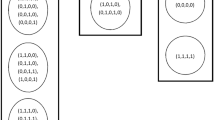Abstract
For an arbitrary group G, it is known that either the semigroup rank \(G{\text {rk}_\text {s}}\) equals the group rank \(G{\text {rk}_\text {g}}\), or \(G{\text {rk}_\text {s}}= G{\text {rk}_\text {g}}+1\). This is the starting point for the research of the article, where the precise relation between both ranks for diverse kinds of groups is established. The semigroup rank of any relatively free group is computed. For a finitely generated abelian group G, it is proved that \(G{\text {rk}_\text {s}}= G{\text {rk}_\text {g}}+1\) if and only if G is torsion-free. In general, this is not true. Partial results are obtained in the nilpotent case. It is also shown that if M is a connected closed surface, then \((\pi _1(M)){\text {rk}_\text {s}}= (\pi _1(M)){\text {rk}_\text {g}}+1\) if and only if M is orientable.
Similar content being viewed by others
References
Ackermann, P., Fine, B., Rosenberger, G.: On surface groups: motivating examples in combinatorial group theory. In: C. Campbell, M. Quick, E. Robertson, G. Smith (eds.), Groups St. Andrews 2005 (vol. 1), London Mathematical Society Lecture Note Series, vol. 339, pp. 96–129. Cambridge University Press, Cambridge (2007)
Benois, M.: Descendants of regular language in a class of rewriting systems: algorithm and complexity of an automata construction. Rewriting Techniques and Applications. Lecture Notes in Computer Science, vol. 256, pp. 121–132. Springer, Berlin (1987)
Cameron, P.J., Lucchini, A., Roney-Dougal, C.M.: Generating sets of finite groups. Trans. Am. Math. Soc. 370, 6751–6770 (2018)
Clifford, A.H.: The free completely regular semigroup on a set. J. Algebra 59(2), 434–451 (1979)
Dowdall, S., Taylor, S.J.: Rank and Nielsen Equivalence in Hyperbolic Extensions, arXiv:1706.02368, preprint (2017)
Dyck, W.: Gruppentheoretische Studien (German). Math. Ann. 20, 1–44 (1882)
Epstein, D.B.A., Cannon, J.W., Holt, D.F., Levy, S.V.F., Paterson, M.S., Thurston, W.P.: Word Processing in Groups. Jones and Bartlett Publication, Burlington (1992)
Hatcher, A.: Algebraic Topology. Cambridge University Press, Cambridge (2002)
Holt, D.F., Eick, B., O’Brien, E.A.: Handbook of Computational Group Theory. Chapman & Hall CRC, London (2005)
Hopcroft, J.E., Ullman, J.D.: Introduction to Automata Theory, Languages, and Computation. Addison-Wesley, Boston (1979)
Kapovich, I., Weidmann, R.: Kleinian groups and the rank problem. Geom. Topol. 9, 375–402 (2005)
Kargapolov, M.I., Merzjlakov, J.I.: Fundamentals of the Theory of Groups. Springer, Berlin (1979)
Lyndon, R.C., Schupp, P.E.: Combinatorial Group Theory. Springer, Berlin (1977)
Mitchell, J.D., Morayne, M., Péresse, Y.: Generating the infinite symmetric group using a closed subgroup and the least number of other elements. Proc. Am. Math. Soc. 139, 401–405 (2011)
Neumann, H.: Varieties of Groups. Springer, Berlin (1967)
Rotman, J.J.: The Theory of Groups: an Introduction, 2nd edn. Allyn and Bacon, Boston (1973)
Sims, C.C.: Computation with Finitely Presented Groups. Cambridge University Press, Cambridge (1994)
Acknowledgements
Mário J.J. Branco and Gracinda M.S. Gomes were supported by FCT (Portugal) through project UID/MULTI/04621/2013 of CEMAT-Ciências. Pedro V. Silva was partially supported by CMUP (UID/MAT/00144/2013), which is funded by FCT (Portugal) with national (MEC) and European structural funds (FEDER), under the partnership agreement PT2020.
Author information
Authors and Affiliations
Corresponding author
Additional information
Communicated by Norman R. Reilly.
Rights and permissions
About this article
Cite this article
Branco, M.J.J., Gomes, G.M.S. & Silva, P.V. On the semigroup rank of a group. Semigroup Forum 99, 568–578 (2019). https://doi.org/10.1007/s00233-018-9982-x
Received:
Accepted:
Published:
Issue Date:
DOI: https://doi.org/10.1007/s00233-018-9982-x



